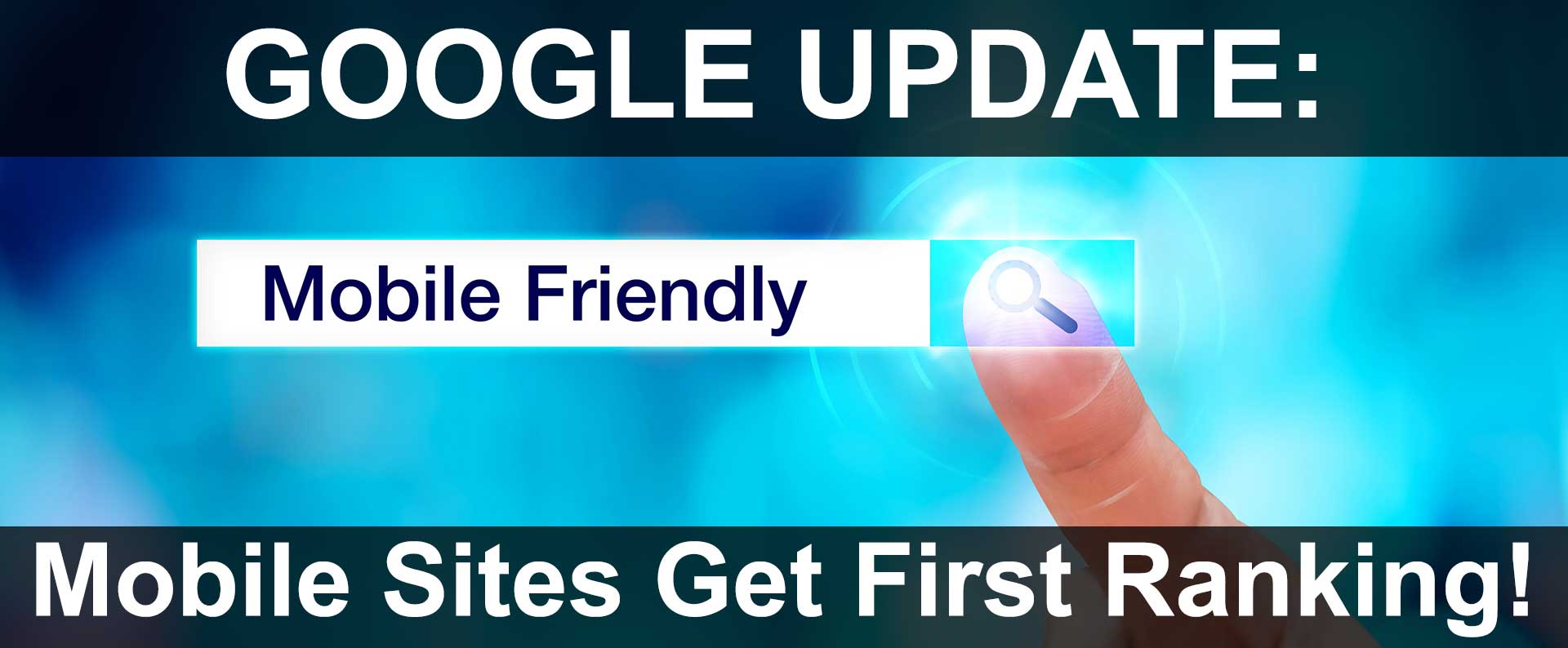Check Out Google's Latest Update!
Click Here To Read Now!
As of November 2016, Google is now implementing and rolling out its "mobile first" plan. This means if a site is not mobile-friendly, it will NOT be listed first in the organic, natural search results.
With over 60% of all searches now done on mobile devices (and growing), this is a huge potential loss of traffic for those businesses that are not yet mobile-friendly.
"To make our results more useful, we’ve begun experiments to make our index mobile-first."
Google has promoted its Mobile-Friendly Test non-stop since April 2015, with an additional push in May 2016. As far as Google is concerned, between these two major announcements over the last two years, they feel they've given ample warning and time for businesses to become compliant.
Google Enforcing Mobile-Responsive Sites
Google has begun enforcing their "mobile-friendly, responsive website mandates" in their search algorithms. This means they have begun utilizing a website's mobile data and content, as a preference for indexing websites for search results:
In a post, Google's product manager, Doantam Phan wrote:
"Although our search index will continue to be a single index of websites and apps, our algorithms will eventually primarily use the mobile version of a site’s content to rank pages from that site, to understand structured data, and to show snippets from those pages in our results."
What this means for businesses with two sites, (a regular desktop site, and a separate mobile-only site) is that the mobile version's site content will be indexed, and preferenced, OVER the more expansive desktop content.
This will be a huge loss in ranking for those businesses that have simply done a band-aid fix (by creating a separate mobile-only website) to account for their information-rich, main desktop site not being mobile-friendly and responsive.
For these businesses with two websites, their new overall Google ranking will be based strictly on the smaller, less information-rich mobile-only website.
In many cases this will mean a lower ranking in search results, because the mobile site is not as information-rich as the desktop counterpart.
It's for this reason we noted two years ago that it's better to have one, responsive website; so ALL of a company's website content gets indexed, not just the mobile-only site's limited content (responsive by definition is mobile-friendly).
There's overwhelming evidence across the board that those businesses that are now responsive AND mobile-friendly have been receiving higher ranking, while generating more traffic and leads this last year, than before.
As previously mentioned, Google did not make a big deal for nothing!
What Does "Mobile-Friendly" Mean to Google?
Google wants a great user experience across all platforms and devices; which means having a mobile-friendly, responsive website. The standard and agreed upon definition of "mobile-friendly" across the internet is:
"Does a website offer the user a good experience on a small screen?"
Google's definition of "mobile-friendly" is a website that is built with a framework that is flexible, automatically adjusting to fit the screen size of any device; whether a small, medium, large or extra large screen. This is known as Responsive Website Design (RWD).
Responsive Website Design allows for a single website to be fluid in layout, adjust, and easy to use on any device or platform.
Some main factors when determining whether a website is mobile-friendly or responsive are:
- Content should be easily readable on a website without having to pinch and zoom
- Navigation menus should be easily rendered on mobile & small-screen devices
- Anchor text (text in links) should have plenty of space so as to avoid "fat fingers" touching multiple links
- Fast page speed and load time over mobile and wireless networks
- Avoid software that is not common on mobile devices such as Flash
- Sizing content so that readers do not have to scroll horizontally
How Will "Responsive Website Design" Requirements Affect My Website & SEO?
Google claims more than 60% of all searches are now on mobile devices; less than 40% of searches are performed on desktops!
Since the majority of all searches now take place on smart phones and small-screen devices, any site that is not mobile-friendly compliant, will miss top ranking in search results.
While Google has been allowing the creation of separate mobile-only sites to supplement the main website not being mobile compliant, this was only a temporary bandaid fix.
Google Wants One Responsive Website
Responsive means one website that properly responds to any screen size, whether mobile, desktop, tablet, or Google-glasses.
For those with a mobile-only website, AND a non-responsive desktop site, run the risk of violating Google's suggested SEO techniques, including:
- Losing ranking due to lower quality mobile-only content getting indexed over higher-quality desktop content
- The risk of creating duplicate content, which can get a website banned from Google
- Not having the same exact content on both mobile and non-mobile websites
- By having a mobile-only site, there is still a mobile-unfriendly site failing to meet Google's requirements
Failing to have one responsive website means that mobile-unfriendly websites may be left out of the 60% of searches now done on mobile & small-screen devices.
Why Do We Need Mobile-Friendly Compliance?
There is an assurance in adopting a certain standard of web design for the industry as a whole. While Google's mobile-friendly requirements may have some profound initial negative affects on those sites that are not yet compliant; in the end, it will provide more stability world-wide.
As with any adoption of new standards in any industry, there is the "time to compliance" that exists as the world works to implement new standards.
These Responsive Web Design (RWD) standards will ensure that websites are designed to work regardless of any new technology and its relative screen sizes.
Whether the new product is a smart pocket watch, super small phone, tablet, notebook, Google Glasses, or some other new piece of technology, websites designed with RWD standards should automatically load and display properly for that screen size.
How Do I Meet Compliance Standards Immediately?
As mentioned previously, all websites now need to be re-designed to use Responsive Website Design (RWD) to meet Google's standards for design on any screen size.
This latest update to Google means that one can no longer simply take the inexpensive, "bandaid fixes" to comply with the new requirements, until such time that they can have their website rebuilt using responsive design standards.
Over the past two years people were able to setup basic "mobile-only" sites to compliment their main desktop-only site using services that simply created a mobile-version of the site to comply with Google's mobile-friendly requirements immediately.
However, often these "mobile-versions" were scaled down versions of the full website, and lacked a great deal of important keyword rich content.
While limited in functionality, having a second, mobile-friendly website did satisfy Google's need to be mobile-friendly until now; today Google prefers a fully functional responsive website design is completed.
Summing Up Google's Changes
The ultimate, end goal to fit in with Google's SEO standards is to have a single site that's responsive regardless of device; the true definition of Responsive Website Design.
Such a scenario makes sense from a "natural & organic SEO" point-of-view:
- There is more chance for inaccuracies when there are two different sites
- One site may not have been updated with the most recent content versus the other
- There are two separate sites versus one responsive site
- One site may not have all the same functionality as the other
Google is coming from a purely "futuristic" point of view; to make sure that websites are built to respond to ANY new technology, whether smart phones, tablets, watches, or any other future technology that arises.













